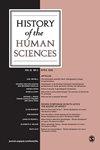For or against the molecularization of brain science?: Cybernetics, interdisciplinarity, and the unprogrammed beginning of the Neurosciences Research Program at MIT
IF 0.5
2区 历史学
Q2 HISTORY & PHILOSOPHY OF SCIENCE
引用次数: 1
Abstract
It was no accident that the first neuroscience community, the Neurosciences Research Program (NRP), took shape in the 1960s at MIT, the birthplace of cybernetics. Francis O. Schmitt, known as the founding father of the NRP, was a famous biologist and an avid reader of cybernetics. Focusing on the intellectual and institutional context that Schmitt was situated in, this article unveils the way that the brain was conceptualized as a distinct object, requiring the launch of a new research community in the US. In doing so, this article moves beyond the dominant narratives on the triumph of molecularization of the brain at the beginning of neuroscience. Instead, it argues that what brought researchers together in the name of neuroscience was not just a molecule but an aspiration to develop biological theories of the brain/mind, which resonated with biologists in a postwar context and was materialized through support for basic research. The article highlights the tension over the computerization and molecularization of the brain, which shaped the interdisciplinary gathering of neuroscientists in the context of growing interest in basic research. Thereby, this article reveals the rise of theoretical concerns in brain science that reflect the distinct desires and concerns of biologists in the US at an intellectual and institutional level. By revisiting the launch of the NRP with a focus on Schmitt, the article sheds light on the historical contingencies in launching the new community as neuroscience in the US and their meaning for the locality and transiency of (inter)disciplinarity in brain science.支持还是反对脑科学分子化?控制论,跨学科,以及麻省理工学院神经科学研究项目的非程序化开端
20世纪60年代,第一个神经科学团体——神经科学研究计划(NRP)——在控制论的发源地麻省理工学院形成,这并非偶然。Francis O. Schmitt被称为NRP的创始人,他是一位著名的生物学家,也是控制论的狂热读者。这篇文章聚焦于施密特所处的智力和制度背景,揭示了大脑被概念化为一个独特的对象的方式,这需要在美国启动一个新的研究社区。在这样做的过程中,这篇文章超越了神经科学之初关于大脑分子化的胜利的主流叙述。相反,它认为,以神经科学的名义将研究人员聚集在一起的不仅仅是一个分子,而是一种发展大脑/思维生物学理论的愿望,这种愿望在战后的背景下引起了生物学家的共鸣,并通过对基础研究的支持而实现。这篇文章强调了大脑计算机化和分子化的紧张关系,这在基础研究兴趣日益浓厚的背景下形成了神经科学家的跨学科聚会。因此,这篇文章揭示了脑科学理论关注的兴起,反映了美国生物学家在知识和制度层面上的独特愿望和关注。通过回顾NRP的启动,重点关注Schmitt,本文揭示了在美国启动新的神经科学社区的历史偶然事件,以及它们对脑科学(交叉)学科的局部性和短暂性的意义。
本文章由计算机程序翻译,如有差异,请以英文原文为准。
求助全文
约1分钟内获得全文
求助全文
来源期刊

History of the Human Sciences
综合性期刊-科学史与科学哲学
CiteScore
1.60
自引率
11.10%
发文量
31
审稿时长
>12 weeks
期刊介绍:
History of the Human Sciences aims to expand our understanding of the human world through a broad interdisciplinary approach. The journal will bring you critical articles from sociology, psychology, anthropology and politics, and link their interests with those of philosophy, literary criticism, art history, linguistics, psychoanalysis, aesthetics and law.
 求助内容:
求助内容: 应助结果提醒方式:
应助结果提醒方式:


